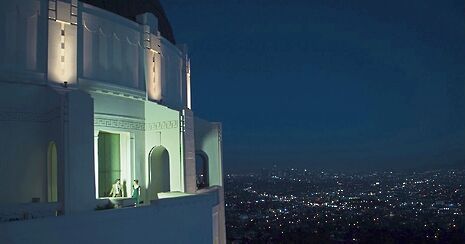Review: Finding love in ‘La La Land’
Can romance exist amid the toxic ambition of Hollywood? Pany Heliotis finds out

Authenticity and artifice, romance and heartbreak, musical and drama: La La Land is a film concerned with duality, the tussle between the disparate, the merging of the oppositional. And what better concerns to have when telling a love story? You’ll hear a lot about La La Land’s retro-stylings this awards season, but what makes this musical truly sing (sorry) is the neurotic romance at its heart.
Imagine Alvy Singer’s adventures in Hollywood and you’ll come close to the masked scepticism and contentious courtship in Damien Chazelle’s third picture, his protagonists trying to balance love and ambition amid LA’s toxic splendour. Gaudy colours abound, primary and pastels, Chazelle tipping his head to your West Side Story-s and Singin' in the Rain-s. But they’re used to paint over a darker canvas.
“The dancing is similarly human, the characters lacking the grace of Kelly but moving with a neurotic tentativeness that’s just as beguiling”
Gosling and Stone deliver as artists fooled by the facade. Stone, wide-eyed and withered, captures the bristling desperation of the invisible actress clambering over ginger clones to be seen. Gosling, coming off The Nice Guys, continues his quest for clown status. His jazz pianist gesticulates with the coiled intensity of a self-elected masochist, wilfully suffering for his art. But their fragile exteriors mask steely ambition and this is when their entanglement gets, well, entangled; the characters forced into bitter compromise and frustration. Like 1980s Woody Allen, separation anxiety, self-loathing and creative ennui fills the air like a melancholy soundtrack.
Speaking of, as I write, it plays in the background and I’m struck by something: its ordinariness. Both leads’ voices are strained like small birds. But this has a deliberate function, the songs are merely bursts of harmony within discord, snatches of fantasy in a painful reality. The dancing is similarly human, the characters lacking the grace of Kelly but moving with a neurotic tentativeness that’s just as beguiling. Chazelle’s point is clear: falling in love is magic but still subject to the laws of humanity, with all the discomfort that entails. However, his message is almost jeopardised by Gosling’s perma-smirk and Stone’s smug surprise, the pair staring at the dancing extras with ironic curiosity and killing the conceit that their collective imagination has somehow elided with their surroundings. Instead, it looks as though they think they are being danced for.
Chazelle’s camera moves like a ballet dancer, pirouetting in and out of the action in a dizzying fashion. Hypnotic fades and percussive cross cuts allow the director to show his hand, building on the language he developed in his sophomore effort, Whiplash. But he is also the film’s hindrance, the dialogue at times drifting into the trite and mawkish. But this is small criticism for a film with such complex ambition, which for the most part it achieves.
An ode to the difficulties of mixing ambition and relationships. La La Land is a fresh spin on the fractured romance – neurosis with melody
 News / Clare Hall spent over £500k opposing busway 24 December 2025
News / Clare Hall spent over £500k opposing busway 24 December 2025 Comment / The ‘class’ of Cambridge24 December 2025
Comment / The ‘class’ of Cambridge24 December 2025 News / Caius mourns its tree-mendous loss23 December 2025
News / Caius mourns its tree-mendous loss23 December 2025 Comment / League tables do more harm than good26 December 2025
Comment / League tables do more harm than good26 December 2025 News / Girton JCR publishes open letter expressing solidarity with Palestine25 December 2025
News / Girton JCR publishes open letter expressing solidarity with Palestine25 December 2025








